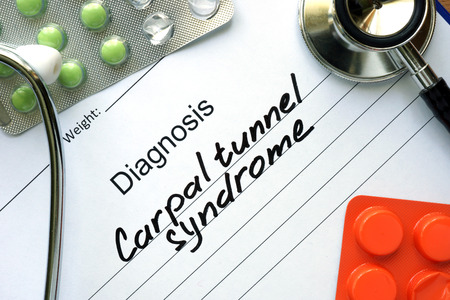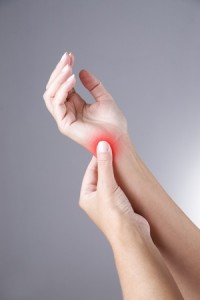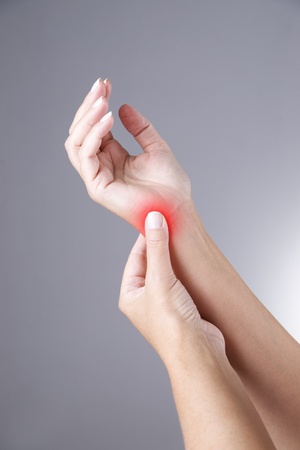Carpal Tunnel and Computer Work
To download a copy of this week’s newsletter, please click here.
Clear Lake Chiropractor Comments: Approximately 2/3rds of employees from industrialized countries use a computer on a daily basis and one of five spend at least 75% of their total work time behind a computer. It’s no wonder so many suffer from neck, shoulder, arm pain, including carpal tunnel syndrome (CTS). There are many reasons for the presence of CTS in office workers who utilize a computer. The following is a partial list of causes:
- The computer screen is not positioned correctly in front of the worker forcing the neck to be rotated to the side or the head has to look up or down too far.
- The mouse and/or keyboard is placed on top of a counter, too high to operate without significant bending of the wrist, often against the sharp edge of the counter.
- The shape of the keyboard is flat, forcing the hands and wrists to pronate (roll inwards) too far. This places more pressure on the nerves in the forearms.
- The use of a mouse usually requires the entire arm to move, frequently running off the mouse pad requiring repositioning.
- Paper work data that needs to be entered in the computer is placed too far off to the side and sustained neck rotation is required during the data entering process.
- The chair and computer desk do not fit the person’s height (either too high or too low) and/or the feet don’t touch the floor.
- There is too much glare from windows or overhead lighting making it difficult to see the screen.
- In the aging worker, poor eye sight requires the use of magnifiers which can be quite distorting when the head is moved, even a small amount.
- There are often other medical conditions that the computer operator may have that increase the likelihood of developing CTS such as obesity, hormone replacement therapy, diabetes mellitus, hypothyroid, the use of birth control pills, and others.

Blogging? flickr photo by Anonymous Account shared under a Creative Commons (BY) license
Therefore, the treatment of CTS must be multi-factorial and sometimes address one or more additional health issues that may co-exist. There are also frequently, many similar overuse types of conditions present in addition to CTS such as neck strain, thoracic outlet syndrome, nerve compression at one or more locations such as the neck, shoulder, elbow, forearm as well as at the carpal tunnel of the wrist. Each patient’s case is unique and a careful history is usually needed to uncover these potential contributing conditions so they can all be properly managed in addition to CTS. Because we spend a lot of our daytime hours at work, a careful work related history is important to identify potential “ergonomic” (design) culprits that can be fixed with simple workstation adjustments. These may include mouse/keyboard placement to an under the desk pull out tray to eliminate the need to overly bend the wrists and eliminate the pressure from the counter top edge. Raising a chair and placing a box under the feet while sitting (for shorter workers), switching to a track ball mouse so only thumb movement is needed to move the pointer (or a touchpad as found on most laptops), an ergonomic keyboard (curved, not flat), moving the screen in front and slightly down from eye level, prop paperwork on a stand-up tray close to the screen so only eye movement is needed, wearing appropriate quality eye glasses possibly with bi- or trifocals, are some potential work station remedies. Treatment that addresses all the contributing issues frequently includes neck, mid-back, shoulder, elbow, forearm, and wrist/hand. Chiropractic care is especially well suited to address these issues because of the whole body treatment approach utilized. We are also well trained in evaluating the work related and will work with your employer to cooperatively improve problems that may be perpetuating the condition. If you or a loved one is suffering with carpal tunnel syndrome, sharing this information may be one of most significant acts of kindness that you can give to those that you care about.
Dr. Ward Beecher practices at Beecher Chiropractic Clinic at 1001 Pineloch, Ste 700 Houston, TX 77062. You can schedule an appointment with your houston chiropractor by calling (281) 286-1300. If you have any questions regarding this blog, please comment below!
Carpal Tunnel Syndrome (CTS) – Common Issues
To download a copy of this newsletter, please click here.
Houston Doctor Comments: You are driving down the road and you notice numbness and tingling in your fingers. You find temporary help by shaking and flicking the fingers, trying to “wake them up.” You’ve also noticed your sleep is becoming interrupted and the need to shake and flick the fingers in the middle of the night is becoming more frequent. If this sounds like you or someone you know, you’re not alone. This condition affects many workers as well as “stay-at-home moms,” as woman are 3 times more likely to develop CTS, or carpal tunnel syndrome, due in part that the carpal tunnel itself is smaller than those in men. Also, women tend to work faster in fast, repetitive jobs, and are often hired specifically for that reason. Further, when workers are paid by the number of pieces they produce, the tendency is to try complete as many pieces as possible so as to make that much more over their base hourly wage.
Basically, CTS is caused by pressure building up in a small confined space through which a nerve (the median nerve) and 9 tendons converge into this tight opening into the hand. When repetitive work/fast movements are performed over hours at a time and day after day, the friction produced by the tendons rubbing against each other results in heat, swelling, pain, and median nerve pinching which produces the classic symptom of tingling/numbness into the 2nd, 3rd and half of the 4th fingers. Hence, those at greatest risk for developing CTS include line workers such as manufacturing, sewing, finishing, cleaning, and fish and/or meat packing. In 1998, 3 of every 10,000 workers lost work time due to CTS of which half missed more than 10 days of work. Considering the increased amount in today’s dollars of medical and disability costs, the average lifetime cost of CTS was estimated at $30,000 for each worker back in 1998.
So, how do you know if you have CTS? The early signs include occasional numbness or tingling in the fingers that you probably wouldn’t think much about since simply shaking your hand or flick the fingers, it goes away. As the numbness becomes more frequent and it does not respond by shaking and flicking the fingers as quickly, you might take notice. Without proper management, difficulty buttoning shirts/cuffs, writing, holding onto small objects, opening jars, all become gradually more pronounced. When sleep becomes interrupted, especially when it becomes necessary to get up and move around before being able to return to sleep, that’s when people usually decide, “I better see someone for this!”
Treatment success is directly related to how fast a person reacts by making a prompt appointment. The best results always occur when care is obtained quickly, when the initial symptoms first appear. In addition, there are sometimes underlying contributors or causes such as diabetes, arthritis, pregnancy, birth control pill use, hypothyroid, obesity, and other conditions that may need proper management in order to relieve the symptoms. Non-surgical care includes the use of wrist splints (especially at night when sleeping), anti-inflammatory measures (medications, gluten-free/paleo diet, vitamin B6 and others such as omega 3 fatty acids/fish oil, vitamin D3 in high doses, calcium, magnesium, CoQ10), work station modifications, forearm exercises, chiropractic manipulation of the neck and arm, acupuncture, and certain modalities such as low level laser/light therapy, can all be helpful.
Surgery should always be considered a “last resort” after all non-surgical approaches have been exhausted. Rarely is there a “medical emergency” that warrants prompt surgical release except in cases of fracture where the carpal tunnel canal is abruptly reduced in size. You need a “quarterback” to help guide you in the treatment/management process. Chiropractors are well trained to manage CTS and offer a non-drug, non-surgical solution to this potentially disabling condition.
Dr. Ward Beecher practices at Beecher Chiropractic Clinic at 1001 Pineloch, Ste 700 Houston, TX 77062. You can schedule an appointment with a Clear Lake chiropractor or by calling (281) 286-1300. If you have any questions regarding this blog, please comment below!
Carpal Tunnel Syndrome and Some of Its Causes
Clear Lake Chiropractor Comments: Research has shown certain work practices and risk factors, such as being overweight, can elevate your risk for developing carpal tunnel symptoms.
As a chiropractor, I often look to the spine when my patients have nerve pain. Many people with carpal tunnel syndrome have a history of a whiplash injury or other neck trauma. But how can a neck injury make me susceptible to carpal tunnel? Simple. When you sprain the ligaments in your neck, this can cause damage and inflammation, which can irritate a nerve where it exits the spinal cord and courses between tiny bones to eventually reach your hand. If the nerve is irritated at the neck region, then this makes it more vulnerable to compression as it passes through the wrist tunnel. Signs that your carpal tunnel pain is a neck problem include shoulder and neck pain and/or a history of a neck trauma.
How can this possibly be fixed “chiropractically”? The first step is to diagnose if you have a primary wrist or neck problem, or a problem with both areas. A thorough examination of the neck,  which may include x-rays, is important. The carpal bones of the wrist can be out of alignment or the vertebrae in the neck can be out of normal position. A specific adjustment can help to correct the abnormal posture and restore mobility.
which may include x-rays, is important. The carpal bones of the wrist can be out of alignment or the vertebrae in the neck can be out of normal position. A specific adjustment can help to correct the abnormal posture and restore mobility.
You may also need to do strengthening exercises, especially if the condition is long-standing or you’ve worn a brace. The muscles of the lower arm are integral to providing wrist support and optimum function
Contractures can develop over time as well, fixating the nerves and not allowing them to glide normally with movements. Deep tissue therapy such as “pin and stretch” and deep massage and break up knots and tight tissues or scarring.
With most patients, alignment is an issue, as is flexibility and strength. I consider the cause of most carpal tunnel symptoms to be multifactorial. Not one exercise, or one pill, or even one adjustment, is right for everyone. However, it’s important to consider conservative options first before deciding on invasive surgery. Even rest and taking pain pills is not really exploring all of the potentially conservative options available.
Dr. Ward Beecher practices at Beecher Chiropractic Clinic at 1001 Pineloch, Ste 700 Houston, TX 77062. You can schedule an appointment at BeecherChiropractic.com or by calling (281) 286-1300. If you have any questions regarding this blog, please comment below!
Facts of Carpal Tunnel Syndrome
To download a copy of this week’s newsletter, please click here.
Clear Lake City Chiropractor Comments:
What is it? Carpal Tunnel Syndrome (CTS) occurs when a nerve on the palm side of the wrist is pinched. It is named after the area of the wrist from where the symptoms occur. The Carpal Tunnel is basically a horseshoe shape made from 8 small carpal bones and the ends of the horseshoe are connected with a ligament thus completing the “tunnel.”
What are the symptoms? CTS symptoms include pain from swelling of the tendons inside the CT. When the nerve pinch occurs, numbness, tingling, or a half asleep sensation into the 2nd, 3rd, and 4th fingers occurs. This is often worse at night due to the wrist being bent when asleep. This often wakes the person and shaking/flicking the hand/fingers is needed to “wake them up.” Grip weakness is also associated with CTS such as difficulty opening jars.
What are the causes? Usually, over use from tasks including repetitive line work (meat/fish/poultry packing, cookie/food packing), typing, sewing, carpentry, waiting tables, and the like. Other “contributors” include hormone related conditions such as hypothyroid, dysmenorrhea, diabetes, and obesity. These fast/repetitive movements cause swelling of the tunnel’s contents (9 tendons and the median nerve) and the nerve is pushed into the ligament connecting the ends of the horseshoe/tunnel.
Who is at risk? Gender is a significant factor as women are 3x more likely to develop CTS than men as the CT may be smaller in woman. The dominant hand is often first affected and more severe. Hormone imbalances as described above also increase risk.
How is it diagnosed? The history of the symptoms as well as physical examination of the hands, arms, shoulders and neck can lead to the proper diagnosis. The exam consists of trying to reproduce the numbness into the fingers by pressing/holding over the CT and other areas where the nerve runs down the arm (including the neck where the nerve originates), tapping over the CT with a reflex hammer, bending and holding the wrists at the extreme endpoints of motion. Also, poking the skin with a sharp object and comparing the 2nd to 4th fingers to other parts of the hand and the opposite side commonly yields differences between the two sides. Questionnaires and hand diagrams completed by the patient are helpful and quantify the degree of severity. Tests used during the course of treatment help track improvements. More sophisticated testing includes an EMG (nerve conduction test) that tests the motor and sensory changes when the nerve is pinched.
How is it treated? Chiropractic approaches include manipulation of the wrist, hand, forearm, shoulder and neck, specifically addressing the areas of greatest restricted motion. Soft tissue therapy includes massage, active release, graston, trigger point, and a host of physical therapy modalities such as light/low level laser, IFC, ultrasound, microcurrent, and low frequency approaches. Exercise training to be repeated multiple times per day is very helpful. Wrist bracing especially at night is also a common treatment approach used by all health care providers. Nutritional counseling and supplementation is also very helpful.
How can it be prevented? Work station assessments, staying in shape (avoid obesity), taking “minibreaks” when doing repetitive work, and proper treatment for conditions like hypothyroid, diabetes, and other disorders associated with CTS.
Dr. Ward Beecher practices at Beecher Chiropractic Clinic at 1001 Pineloch, Ste 700 Houston, TX 77062. You can schedule an appointment at BeecherChiropractic.com or by calling (281) 286-1300. If you have any questions regarding this blog, please comment below!
Suffering from CTS? Prompt Treatment is Best!
To download a copy of this week’s newsletter, please click here.
Houston Chiropractor Comments: Many people suffer from CTS (Carpal Tunnel Syndrome) and unfortunately, often ignore the initial symptoms of numbness or tingling in the hand(s). These early symptoms are typically not too alarming and hence, they often do not raise the level of concern until more intense symptoms occur; such as waking up from sleep due to numbness, dropping items, difficulty buttoning clothing, needing to switch hands when driving, difficulty writing, typing, knitting, as well as work related pain. There may also be fear of job loss associated with CTS, especially in these hard economic times with frequent lay offs, prompting CTS sufferers to postpone initial care. Unfortunately, delaying treatment is associated with a longer recovery time when compared to prompt management which usually results in a quicker, less complicated and more satisfying recovery.
There are many causes and contributing factors of CTS. The most prevalent cause is mechanical irritation from simply moving the hands too fast for too long, without enough rest. Another risk factor is age (over 50 years old). In this era of an aging workforce, this may be a significant issue. Fast, repetitive movements of the arms and hands are often a direct cause and can be appreciated by watching someone knit rapidly and/or performing line work using fast, repetitive movements. If the hands/wrists have to bend in awkward positions to accomplish a work task, or if a tool that is frequently used places pressure in the palm of the hand, these can also contribute to the onset or perpetuation of CTS. Other conditions can also contribute to CTS including inflammatory arthritis like rheumatoid, diabetes, pregnancy, the use of birth control pills, obesity and hypothyroidism.
The management of CTS is case specific, and is dependant on which of the above mentioned causes or contributors are present. Management of any metabolic disorder such as diabetes or hypothyroid is important, especially compliance with taking appropriate medication, when indicated. The management of weight, hormone replacement therapy, and fluid retention all play a roll in CTS management. Ergonomic or job-related management strategies are very important and can include work station modifications so that unnecessary awkward arm/wrist/hand positions can be avoided. This may require moving the item being worked on to a less stressful position, using a different type of tool handle (screw driver, etc.), changing the height or reach distance at which the material is worked on, and taking “mini-breaks” every ½ to 1 hour when the lack of rest is a contributor. Frequently, the combination of pinching a phone between the head and shoulder, typing data into a computer where the monitor is positioned too high or off to one side, and excessive arm motions using a computer mouse can contribute to pinching the nerve in the neck and/or arm, resulting in CTS. Remedies for this situation include the use of a head set, repositioning the computer monitor so that it is in front of the worker, and using a trackball type of mouse to eliminate arm motion can be extremely helpful. Treatment strategies offered by chiropractors include the use of night splinting to avoid awkward wrist/hand positions during sleep. In addition, manual therapy to the wrist and the tight muscles in the front of the forearm, as well as other nerve constriction areas such as the elbow, shoulder, and neck, manipulation of the joints in hand, wrist, elbow, shoulder, and/or neck, depending on what is unique and needed for that patient, and the use of physiological therapeutics such as low level laser light therapy, electrical stimulation, and/or ultrasound have all been shown to offer beneficial effects. Nutritional recommendations include Vitamin B6 (150mg/day), magnesium, calcium, Co-Q10, omega 3 fatty acids and vitamin D3. Reducing glutens (wheat, oats, barley, and rye) is also very important due to the inflammatory response of these foods. Surgery is typically, the last treatment resort and is appropriate, “when all else fails.” We welcome you to our clinic and are proud to offer you a non-drug, non-surgical solution for CTS and its disabling symptoms.
Dr. Ward Beecher practices at Beecher Chiropractic Clinic at 1001 Pineloch, Ste 700 Houston, TX 77062. You can schedule an appointment at BeecherChiropractic.com or by calling (281) 286-1300. If you have any questions regarding this blog, please comment below!

